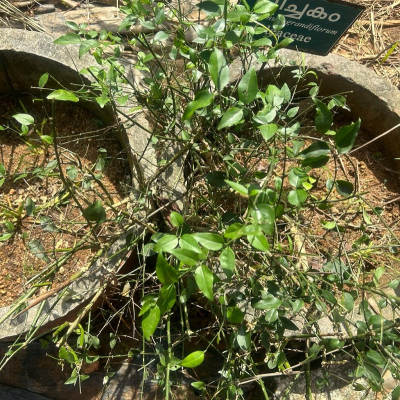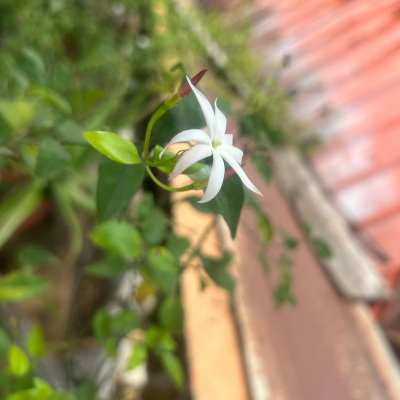Distribution and Habitat: Subtropical, often cultivated in Indian gardens. It is a native of Kashmir
Botany: A large twining nearly glabrous shrub, often seen sub erect, branches striate.
- Leaves: Opposite, imparipinnate, 5-12.5 cm long, petiole and rachis margined.
- Flowers: 3-3.8 cm, across, white, often tinged with pink outside, in lax axillary and terminal cymes longer than the leaves. Calyx 5-10 mm long, glabrous, tube 2.5 mm long or less; lobes 5, subulate, 2-3 times as long as the tube. Corolla tube 1.8- 2.5cm long; lobes 5, elliptic or obovate.
- Fruit: Berry, black in colour.
Properties: Anthelmintic, diuretic, emmenagogue, astringent and aphrodisiac
Chemical constituents: Benzyl alcohol, benzyl acetate, d-linalool, linalyl acetate, jasmone, indole, and methyl anthranilate.
Uses: worms, scorpion –sting, cephalalgia, mental debility, giddiness, paralysis, amenorrhea,
fixing loose teeth, ulcerative stomatitis, otalgia, strangury, cephalopathy, odontopathy, ophthalmopathy
Formulations: Jatyaditaila, jatyadi-ghrita, jatyadi-varti etc.
Agrotechnology:
Soil and climate: Well drained loamy soil, and a variety of soils such as black, lateritic, clay-loam and gravelly loam. Jasmine is a sun loving plant and prefers warm humid climate for successful growth. Areas having a warm summer and mild winter with sun almost throughout the year are considered the best. Propagation: stem cuttings.
Irrigations: The irrigation is given if soil moisture is inadequate.
Manures and Fertilizers: Pits are filled with top soil, cowdung and compost. Plant needs 15-30 kg FYM, 60-120 gm N, 120-240 g P2O5 and 120-240 g K2O plant/year which are given in 3-4 split doses.
Plant protection:
Pests:
- Bud worm: Small green caterpillars of insect feeds on flower petals and bore into buds resulting in fading of colour and destruction of buds due to excreta.
- Blossom midge: Mosquito like adult midges lay eggs at base of flower buds. Maggots enter buds and feed from within. Buds get discoloured and dry off.
- Flower thrips: Adults and nymphs of thrips feed on sap of buds and flowers. Affected flowers turn violet and dry off.
- Gallery worm: Caterpillars of insect fold together leaves, buds and growing tips of branches and feed from within. If damage is severe, plants get stunted and die off.
- Leaf thrips: Leaf thrips are seen in large numbers on lower surface of leaves and feed on leaf sap. Due to infestation, leaves become leathery and yellowish and drop off.
- White flies: Adults and nymphs of white flies suck sap from lower surface of leaves and as a result, leaves become yellowish and pale.
- Floral mites: Small yellowish mites infest floral buds. Infested buds do not open and get crinkled. Size of the buds will be reduced due to infestation.
- Foliar mites: Mites infest in colonies on lower surface of leaves. Infested leaves become yellow and drop off.
- Lace wing bugs: Adults and nymphs of these bugs feed on leaf sap from lower surface. Yellowish patches develop on leaf surface and later they dry and drop.
- Grass hoppers: Grasshoppers feed on leaf lamina but generally not a serious problem.
- Stem borer: Larva bore into stem and affected stem dries off.
Control of insect pests: Against caterpillars and leaf feeding insects, quinalphos EC at 2ml/ l, carbaryl WP at 4g/ l or hostathion EC at 2 ml/ l shall be sprayed on need basis. Sap sucking insects can be controlled by dimethoate EC at 2 ml/ l, phosphamidon EC at 0.5 ml/ l, imidachloprid EC at 0.5 ml/ l or acephate SP at 1.5 ml/ l. Application of dicofol 2 ml/ l, wettable sulphur 3 g/l or ethion 1 ml/ l are effective against mites attacking jasmine.
Diseases
- Leaf spot: Leaf spots appear on leaf surface and in severe cases, defoliation occurs. In initial stages of infection, affected leaves can be collected and destroyed. In case of severity, mancozeb 2-4 g/ l or carbendazim 1 g/ l or benomyl 2 g / l or captafol 3 g/ l are effective.
- Die back and rust: Symptoms of damage are drying of leaves, breaking of skin of branches and drying of entire branches. Removal and destruction of dried branches and spraying of fungicides such as mancozeb 2-4 g/ l or carbendazim 1 g/l or benomyl 2 g/ l or captafol 3 g/ l are remedial measures.
- Sooty mould: Black mould appears on leaf surfaces and reduces photosynthesis thereby affecting growth of plants. Spraying of diluted starch solution and 1% BM are effective against the problem.
- Bacterial wilt: Plants get wilted in a week and die off by bacterial infection. Removal and destruction of affected plants and application of copper hydrate at 1 g/l or oxytetracyclin compounds (500 ppm) soil drenching are effective against disease.
Harvesting: Plant flowers from second year of planting. Flowering period ranges between April and May and from August to November. In Egypt, plant flowers almost 10 months in a year. Harvesting is done during early morning because flowers contain maximum perfume at this time. Flowers gathered at noon and in afternoon yield lesser flower oil than those collected very early in the day. Warm weather and ample sunshine yield a crop of heavily scented flowers than in cool or rainy weather. Annual yields of flowers are reported to be 750‑1000 kg/ ha in India, 2000‑4000 kg in France, 4500‑5500 kg in Sicily and Italy and upto 6000 kg/ ha in Morocco and Egypt. A jasmine plantation gives economic yield for 10‑15 years after which crop is removed and crop rotation followed for some years before establishing a new jasmine plantation.
Processing: The essential oil in flowers is extracted through enfleurage which is widely used for production of jasmine attars in India. In this method, seeds of sesame are first soaked in water with a view to remove their covering and then dried in sun. The fresh jasmine flowers and the dehusked seasame seeds are spread in thin layers, for 10-12 hours daily. The exhausted blossoms are replaced by fresh flowers and this process is repeated for 5-7 days till all the dehusked seeds are saturated with perfume. The perfume seeds are distilled and the vapours of jasmine are absorbed in to sandal wood oil for production of attars. Solvent extraction, with petroleum ether or hexane, recovers practically all the odour constituents. Jasmine oil is also separated from jasmine concrete by liquid carbon dioxide extraction method.



